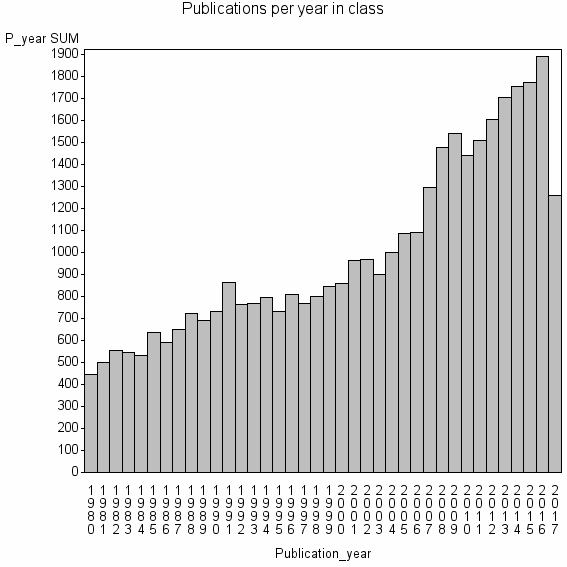
Class information for: |
Basic class information |

Hierarchy of classes |
The table includes all classes above and classes immediately below the current class. |
| Cluster id | Level | Cluster label | #P |
|---|---|---|---|
| 7 | 4 | CARDIAC & CARDIOVASCULAR SYSTEM//PERIPHERAL VASCULAR DISEASES//CARDIOL | 1572904 |
| 334 | 3 | HYPERTENSION//ARTERIAL STIFFNESS//AMBULATORY BLOOD PRESSURE MONITORING | 37828 |
| 313 | 2 | ARTERIAL STIFFNESS//AMBULATORY BLOOD PRESSURE MONITORING//BLOOD PRESSURE MONITORING | 18655 |
| 1592 | 2 | MEDICATION ADHERENCE//ADHERENCE//HYPERTENSION | 7424 |
| 2171 | 2 | LEFT VENTRICULAR HYPERTROPHY//LEFT VENTRICULAR MASS//POST EXERCISE HYPOTENSION | 5280 |
| 2292 | 2 | WALL SHEAR STRESS//CAROTID BIFURCATION//OSCILLATORY SHEAR INDEX | 4845 |
| 3458 | 2 | WAVE INTENSITY ANALYSIS//ELASTIC TUBES//PULSE WAVE PROPAGATION | 1624 |
Terms with highest relevance score |
| rank | Category | termType | chi_square | shrOfCwithTerm | shrOfTermInClass | termInClass |
|---|---|---|---|---|---|---|
| 1 | HYPERTENSION | authKW | 769496 | 16% | 15% | 6167 |
| 2 | ARTERIAL STIFFNESS | authKW | 568553 | 4% | 48% | 1432 |
| 3 | AMBULATORY BLOOD PRESSURE MONITORING | authKW | 541888 | 3% | 64% | 1014 |
| 4 | BLOOD PRESSURE MONITORING | journal | 488500 | 2% | 78% | 751 |
| 5 | PULSE WAVE VELOCITY | authKW | 449999 | 3% | 54% | 1011 |
| 6 | PERIPHERAL VASCULAR DISEASES | WoSSC | 440819 | 32% | 5% | 11993 |
| 7 | JOURNAL OF HYPERTENSION | journal | 374666 | 6% | 22% | 2103 |
| 8 | BLOOD PRESSURE | authKW | 366085 | 8% | 14% | 3175 |
| 9 | AMBULATORY BLOOD PRESSURE | authKW | 316301 | 2% | 57% | 665 |
| 10 | JOURNAL OF HUMAN HYPERTENSION | journal | 287510 | 3% | 31% | 1139 |
Web of Science journal categories |
| chi_square_rank | Category | chi_square | shrOfCwithTerm | shrOfTermInClass | termInClass |
|---|---|---|---|---|---|
| 1 | Peripheral Vascular Diseases | 440819 | 32% | 5% | 11993 |
| 2 | Cardiac & Cardiovascular System | 92818 | 20% | 2% | 7655 |
| 3 | Medicine, General & Internal | 28392 | 14% | 1% | 5274 |
| 4 | Engineering, Biomedical | 13484 | 5% | 1% | 2001 |
| 5 | Primary Health Care | 6158 | 1% | 2% | 516 |
| 6 | Pharmacology & Pharmacy | 4184 | 9% | 0% | 3304 |
| 7 | Health Care Sciences & Services | 3513 | 3% | 1% | 951 |
| 8 | Public, Environmental & Occupational Health | 2917 | 5% | 0% | 1908 |
| 9 | Physiology | 2816 | 4% | 0% | 1501 |
| 10 | Geriatrics & Gerontology | 1811 | 1% | 1% | 558 |
Address terms |
| chi_square_rank | term | chi_square | shrOfCwithTerm | shrOfTermInClass | termInClass |
|---|---|---|---|---|---|
| 1 | HYPERTENS UNIT | 73242 | 1% | 25% | 353 |
| 2 | HYPERTENS | 68634 | 1% | 18% | 452 |
| 3 | PLANNING DRUG DEV CLIN EVALUAT | 50511 | 0% | 54% | 112 |
| 4 | EPIDEMIOL STUDIES CLIN TRIALS | 48011 | 0% | 61% | 95 |
| 5 | PHARMACEUT SCI MED | 47482 | 0% | 51% | 113 |
| 6 | BIOENGN CHRONOBIOL S | 47450 | 0% | 71% | 80 |
| 7 | CARDIOL | 45560 | 8% | 2% | 3165 |
| 8 | STUDIES COORDINATING | 34784 | 0% | 44% | 95 |
| 9 | INTERUNIV FISIOL CLIN IPERTENS | 33395 | 0% | 62% | 65 |
| 10 | HYPERTENS CARDIOVASC REHABIL UNIT | 32532 | 0% | 42% | 94 |
Journals |
| chi_square_rank | term | chi_square | shrOfCwithTerm | shrOfTermInClass | termInClass |
|---|---|---|---|---|---|
| 1 | BLOOD PRESSURE MONITORING | 488500 | 2% | 78% | 751 |
| 2 | JOURNAL OF HYPERTENSION | 374666 | 6% | 22% | 2103 |
| 3 | JOURNAL OF HUMAN HYPERTENSION | 287510 | 3% | 31% | 1139 |
| 4 | AMERICAN JOURNAL OF HYPERTENSION | 268444 | 4% | 23% | 1397 |
| 5 | JOURNAL OF CLINICAL HYPERTENSION | 149671 | 1% | 39% | 463 |
| 6 | BLOOD PRESSURE | 122562 | 1% | 39% | 383 |
| 7 | HYPERTENSION | 115033 | 3% | 11% | 1277 |
| 8 | HYPERTENSION RESEARCH | 97730 | 1% | 21% | 553 |
| 9 | JOURNAL OF THE AMERICAN SOCIETY OF HYPERTENSION | 55032 | 1% | 31% | 214 |
| 10 | CLINICAL AND EXPERIMENTAL HYPERTENSION | 48817 | 1% | 17% | 351 |
Author Key Words |
Core articles |
The table includes core articles in the class. The following variables is taken into account for the relevance score of an article in a cluster c: (1) Number of references referring to publications in the class. (2) Share of total number of active references referring to publications in the class. (3) Age of the article. New articles get higher score than old articles. (4) Citation rate, normalized to year. |
Classes with closest relation at Level 3 |